#coloniality and nature
Text




"after all, how can one feel the loss of a thing whose existence one has become unconscious to?"
a wonderful collection of essential and constant truth bombs.
#india that is bharat#j. sai deepak#indian literature#indian history#non fiction#decolonisation#indigineous people#indigenous faith#coloniality and nature#indian academia#booklr#studyblr#notes#long reads#coffee#dark academia#light academia#desiblr#study blog#book photography#vsco
1K notes
·
View notes
Text
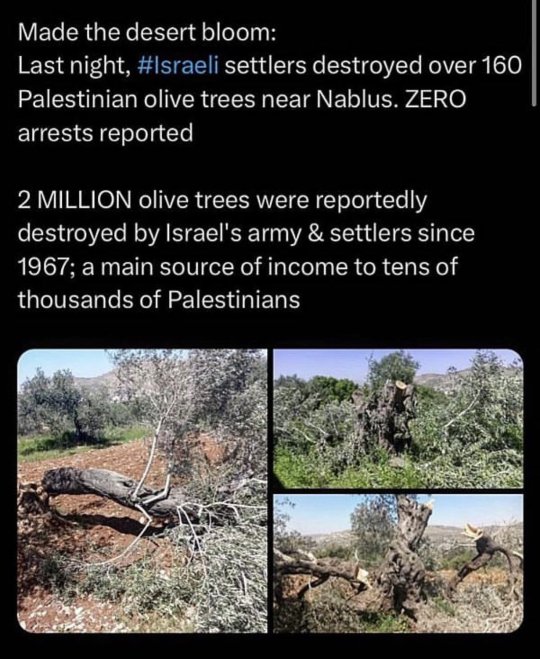

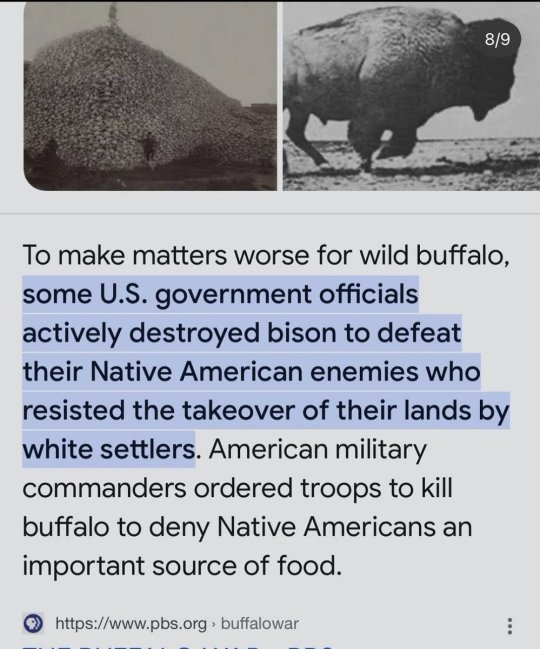
US literally is a teaching guide for war crimes.
#free palestine#politics#news#palestine#west bank#democrats#republicans#trees#botany#nature#native americans#military#woc#poc#women of color#colonialism#colonization#usa
8K notes
·
View notes
Text
A historically and culturally significant lake in California's San Joaquin Valley that first disappeared in 1898 has returned after last year's atmospheric rivers flooded the region.
Tulare Lake, known as Pa'ashi — or "big water" — to the local Tachi Yokut Tribe, was "once the largest body of freshwater west of the Mississippi River," per Earth.com.
Vivian Underhill, who published a paper on Tulare Lake as a postdoctoral research fellow at Northeastern University, noted it was mostly sustained by snowmelt from the Sierra Nevada mountains and was 100 miles long and 30 miles wide at its peak.
The lake served as a key resource for Indigenous Peoples and wildlife and was once robust enough to allow steamships to transport agricultural goods throughout the state.
However, government officials persecuted and displaced the indigenous communities in the late 1800s to convert the area for farming through draining and irrigation.
"They really wanted to get [land] into private hands so that indigenous land claims — that were ongoing at that time — would be rendered moot by the time they went through the courts," Underhill told the Northeastern Global News. "It was a deeply settler colonial project."
While Pa'ashi periodically reappeared during the 1930s, '60s, and '80s, the barrage of atmospheric rivers California experienced in 2023 revived the lake despite the region receiving just 4 inches of rain annually. According to Underhill, Tulare Lake is now the same size as Lake Tahoe, which is 22 miles long and 12 miles wide.
Its resurgence has led to the return of humid breezes at least 10 degrees cooler than average and native species, including fish, amphibians, and birds. Lake Tulare was once a stopping point for migratory birds traveling a route known as the Pacific Flyway.
"Something that continues to amaze me is — [the birds] know how to find the lake again," Underhill told the Northeastern Global News. "It's like they're always looking for it."
The Tachi Yokuts have also returned to Pa'ashi's shores, once again practicing their ceremonies and planting tule reeds and native sage.
#submission#!!!#good news#lakes#Tulare Lake#Pa'ashi#big water#water#water is life#revitalization#anti colonialism#decolonization#nature#Tachi Yokut#indigenous peoples
463 notes
·
View notes
Text
also I know I’m strolling in seven years late to Horizon’s representation problems but I feel like these games are an instructive example in how the liberal imagination understands “good representation.” the game seems to take a lot of care in demonstrating (what the developers understand to be) a fully post-racial society by way of universal racial integration - every society or ‘tribe’ or group of people you encounter is almost uniformly racially diverse. Being generous, I think this is an attempt to avoid any possible racist implications in the fanciful costumes and outfits that Horizon is known for; there is a lot of focus in representing the different people of Horizon’s world through what they wear. You can immediately tell an Oseram from a Carja, not by their racial makeup, but by their clothing. This means that, if you meet a particularly ‘savage people’ (a term characters in the game use semi-frequently) who wear ‘exotic clothing’ and face-paint, the diverse racial makeup of the group prevents (or is intended to prevent) a racist conclusion about that group.
Likewise, the game presents a world free from systemic homophobic prejudice - Aloy is notably gay, but also her asking people about their partners, or assuming other people around her are gay, generally passes without comment. Horizon is presenting a fully ‘integrated’ social world, one whose conflicts are not meant to map onto ‘modern-day’ racism and homophobia.
But the underlying logic and structure of racism and homophobia (and binaristic, oppositional gender) are left intact. Humanity in Horizon is still presented as fundamentally separate from nature, moving overtop of it, extracting what they need from it, but never part of it as such. And this construction of nature as separate from “man” is not problematised, “man” just gets universalised into “human,” and “human” gets universalised into a non-racial category. This is completely side-stepping the history of this construction of nature as a white supremacist, colonial, capitalist construction, an understanding of nature as something colonial Europe is meant to hold dominion over through the dehumanisation of non-white, non-European people, converting them into non-human labourers and pests who live atop the land Europe is attempting to colonise and enclose. “Nature” in the modern western understanding is a fundamentally racial concept; nature is a ‘scientific, rational, biological’ container meant to house everything non-human about the world, an object to be studied and exploited by the one true subject of history, Mankind - and who is considered part of mankind is a question of whether you belong to the white European ruling class.
I think Aloy in particular represents this problem well - her access to and understanding of pre-apocalypse technology makes her universally suspicious and dismissive of any religious or ‘spiritual’ beliefs she encounters in other groups, frequently getting into reddit-atheist-adjacent quibbles with the ‘unenlightened,’ ‘primitive’ people of the world about the fact that the machines that harvest food for them and take care of the land are not gods, silly, they’re just machines! Her only real counterpart in terms of technological understanding is Sylens (a Black man), who is an antagonist. Like despite the game’s attempts at neutralising race as a coherent category, it is kind of unavoidable to notice that the protagonist is a white woman who’s only equal is a Black man engaging in constant deception for his own benefit lol
And Aloy’s anti-religious sentiments are deeply funny, because the game’s narrative itself has a theological relationship to technology - humans destroyed the world with technology, yes, but salvation of humanity is only possible through technology, specifically a globe-spanning technological system meant to be an environmental steward to the planet, repairing the damage caused by previous technological catastrophes and human wars. Human beings themselves are insufficient to the task of taking care of the planet, and “nature” itself is incapable of self-governance or regulation. And the way this technological system is made to function properly again is, hilariously, unlocked through the genetic code of a white woman, a perfect clone of the technological system’s original creator. the solution to Horizon’s central conflict and threat is, ultimately, a white saviour
And so the appropriative elements of Horizon - calling the Nora ‘braves,’ the abstracting of hundreds of north american Indigenous cultures into mere aesthetics and symbols, the invocation of words like savage and primitive, and so on - are not surface-level problematic elements of an otherwise anti-racist game, they are indicative of a liberal anti-racist imaginary, a place where we’re all equal human beings whose main problem are vague sectarian grudges, without looking at or dealing with any of the underlying ideological frameworks that produced race or gender in the first place.
So I think Horizon is, despite attempts to imagine a post-racist world, nonetheless very limited in how it represents this post-racial world because it understands racism as prejudice against particular phenotypic characteristics, not an underlying logic that renders “nature” and “human” as fundamentally racial concepts in history
#um. idk what to tag this#also what’s the consensus on citing sources for tumblr posts. I’m using Quijano and Lugones’ work on coloniality of power & gender if you#want to read more about the colonial history of nature#I should probably just post excerpts of those works instead#horizon
150 notes
·
View notes
Text
no but really the focus on pronouns Determining Actual Gender And Having Unique Social Roles in lgbt spaces is absolutely bizarre and beyond any form of basic material analysis of gender it exists in the real world. like speaking from experience you can literally be a stone butch lesbian who goes out of ur way to exclusively dress in traditionally masculine clothes, who uses a masculine name, who intentionally and explicitly plays a complex and deeply nonconforming gender role as both social performance art and for personal fulfilment, and then get lumped in by other lgbt people in the category of "she/her type" (and, more broadly, if you use she/her and are afab, you inevitably get labeled as 'cis' regardless of your actual gender performance as interpreted by the world writ large) just because you dont care enough about pronouns to determine and enforce the use of any others for yourself
#i think ultimately from a Sincere Gender Studies Position the fixation on pronoun use is a reflection of the performative nature of gender#being taken to its natural extreme by people who read half of gender troubles and both understand that Gender is a Role We Play For Others#and paradoxically wanting to be recognized and respected in that role even though they understand that its a losing game#and further i think that ultimately linguistically pronouns are a hot cultural point in english speaking countries#but the shitty nitty gritty of gender and its identifiers being a construct of colonial import#is that if we lived in a planned culture where such a thing could be mandated we should move to a one-pronoun system without the capacity#for assigned gender roles#not have multiple (countless) pronoun configurations with an Assigned Gender Role for each one#but thats just my two cents
640 notes
·
View notes
Text

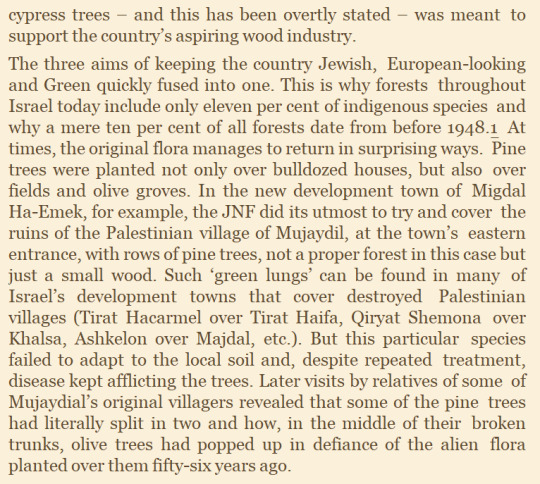
The Ethnic Cleansing of Palestine - Ilan Pappé (2006)
#the rejoicing that must have occurred - i can imagine word spread fast#zionists probably took this as a personal attack by nature. good.#The Ethnic Cleansing of Palestine#Ilan Pappé#Palestine#Israel#Free Palestine#Free Gaza#ethnic cleansing#zionism#nsnv#colonialism#atypicalreads#politics#history#state of israel#nonfiction#olive trees#Ilan Pappe#mujaydil#conifers#natural flora#indigenous#cypress#pine#trees#migdal ha-emek#jnf#jewish national fund#green lungs
159 notes
·
View notes
Text
Happy September 🍂

Instagram — @melvolkman
#autumn#fall#cozy#magical#nature#magic#leaves#moody#halloween#cottagecore#Maine#New England#September#September 2023#autumn aesthetic#moon autumn magic#haunting#old house#antique#New England colonial#homestead#slow living#nature lovers
279 notes
·
View notes
Text
Genuinely confused as to how so much of the fandom watched the first 2 CR campaigns and Calamity and yet still ended up in a “Ludinus is right let’s kill all the gods” position. Like it’s baffling to me how much content/context people have just decided to completely forget? We had 2 full campaigns of very positive interactions with the gods and the moment there’s some hypothetical and interesting musing and speculation about their roles in the world from a more disconnected place we’re just throwing that out the window?*
Tbh the number of people who watched episode 4 of Calamity and still saw Asmodeus as sympathetic or having a legitimate point is unsettling to me, but while that’s a related issue it’s not quite the same conversation.
But like legitimately how did we so quickly make a hard turn from “The Stormlord teaches his barbarians to use the power of friendship, he’s a funny kindergarten teacher” memes to…this.
*(This is not, btw a comment on the characters having philosophical debates in-world because I think those are interesting and on-theme for the campaign and are also nearly always concluding with “our personal relationship to individual gods and feelings about them are irrelevant actually, the people trying to destroy them are doing wider harm and are in the wrong and must be stopped.” I’m actually loving the engagement with this by the characters in-universe but the fandom is exhausting me.)
#people stop engaging with all fantasy religion like it’s the same as bigoted evangelical American Christianity challenge#oh also the ‘the gods are colonial invaders’ take is also super weird to me because that’s applying recent human history to what is#basically standard like Greek or Roman creation myth?#like a ton of European pagan lore has a ‘the gods we worship came from afar and tamed the wilds of nature’ narrative#it is a metaphor#cr discourse#legit saw someone this morning confidently posting ‘well Ludinus just is right though!’ and I wanted to close down the whole internet#critical role
574 notes
·
View notes
Text
Environmental Generational Amnesia: When We Forget Nature’s Past
Originally posted at my blog at https://rebeccalexa.com/environmental-generational-amnesia/
One of the most traumatic and formative experiences of my life occurred when I was thirteen years old. The woods that I loved exploring behind our yard were completely bulldozed one day; I discovered this when I got off the bus from school. It was part of the destruction of an entire wild area that would become yet another subdivision devoid of trees and vines and wildflowers, with no place left for bobwhite quail or garter snakes in the flat green lawns. I was devastated, and in an attempt to try to help me my mom chatted with the developer when she happened to run into her in town. “She knows how you feel,” my mom said. “Her woods were the ones that were torn down to make the junior high track.” Not only did it just not make sense to me that someone who had been through what I was experiencing would then go on to do the same horrible acts, but it was also my first introduction to the reality of environmental generational amnesia.

The term was coined a few years ago in a paper by Peter Kahn and Thea Weiss. It refers to how each generation considers how it first experienced a place as its true baseline, and any change that comes after it is abnormal or unnatural. So for me, the track at my junior high with just a line of trees along the creek was my understanding of its baseline, but the developer remembered that land as acres of woods. A hundred years ago it may have been a farm. Go back several generations to when only the Osage lived here, and it was probably undamaged oak savanna, or perhaps a tallgrass prairie.
When you multiply that shifting understanding of the “normal” state of a place by all the people in a given area, something is bound to be lost as generations die off, and new ones are born into the present state. Couple that with a serious lack of nature literacy, and you have fewer people discussing what the place is versus what it once was.
In cases where almost all the land has been significantly changed by human activity for centuries, it can be incredibly challenging to piece together what it was like before we came through and wrought such imbalances. The only evidence may remain in a few remote undamaged patches, scraps of partial plant and animal communities, and oral and written information passed down by people, whether indigenous or colonizing. Sometimes ecologists and other scientists need to look at the ecosystems of neighboring areas to get some idea of what might have been here before. It’s often a matter of trying to piece together an incomplete puzzle, giving best educated guesses as to what filled the empty niches.

If you have a population that has a dim memory at best of what a place looked like before it was changed at all, they’re less likely to understand when there’s a problem. I knew, for example, that it was wrong to tear down the woods behind my home, but my baseline was “mix of trees and shrubs of various species surrounding a creek with a limestone bed next to a twenty year old subdivision.” No one could tell me what that farm looked like before it became a farm, and I didn’t understand at the time that the mix of plants and animals I knew and loved were neither the complete original assortment, nor were they all native. How was I to know that my yard was once spacious grassland, dotted with white oak here and there? How should I have come to understand that the woods I had cherished were badly out of ecological balance compared to what had once been, that they were exhibiting signs of recolonization after multiple massive disturbances before I was even born?
And this is just one example of one person’s understanding of one place. This environmental generational amnesia has rippling effects worldwide, with people not understanding that the rivers nearby aren’t supposed to be as stick-straight as they are, that the coastline should be covered in wetlands rather than open sand, that the dense forest is only there because natural fires were suppressed and allowed the trees to take over the last meadows. There are even those who have no idea that their air, water, and soil aren’t supposed to be loaded with pollutants, because pollution is all they’ve known for generations. It’s tough to imagine an extinct wetland when you can’t even see the water for the trash, and the sky is brown instead of blue.
It’s not going to be an easy task to try to revive the collective memory of Lands That Were. A good starting point is to talk to our elders, both alive and dead. When we ask those who still live what they remember of a place, we can glean important details even if they themselves weren’t ecologists, or formal scientists of any other sort. If we can take them to these places and have them show us where important landmarks were and describe what has changed, we can start to see more clearly what’s been lost. And when we read the writings and view the landscape art of those who are long passed, we get important snapshots of what was there long before any of us today were alive, tracing that ecological story closer to its origin.

We also need, more than ever, to preserve what ancient ecosystems still remain, whether that’s old growth forests, or prairies that never knew the tearing of the plow, or wetlands never drained or polluted. We can’t just miraculously replace them in a matter of a few years, and they offer us crucial pictures of the end goal in places where we are attempting long-term habitat restoration. They are living, breathing records of what places looked like before, of the biodiversity and other natural structures that were in place for thousands of years.
Finally, we need to be talking openly about the disconnect between what is and what was. If I, as an incredibly nature-obsessed kid, was startled to think about how my “normal” was only a faint shadow of past ecological glory, then imagine how jarring it must be for someone who is further removed from nature to understand that the forest they walk through is really supposed to be a prairie. (Especially after many years of being told that “planting trees” is the answer to all the ecological problems we face!)
With time and education we can bring about awareness, and that awareness will help us make better decisions for the future. There are so many people who want to undo ecological destruction and make the world a better place; we just need to have better, more accurate information out there on what can be reasonably done. Much of that hinges on having a clearer idea of what’s been lost, so that we can make plans to save whatever is left, and restore as much as we can.
Did you enjoy this post? Consider taking one of my online foraging and natural history classes, checking out my other articles, or picking up a paperback or ebook I’ve written! You can even buy me a coffee here!
#long post#ecology#habitat restoration#environment#environmentalism#conservation#nature#science#scicomm#colonialism#wildlife#natural history#outdoors#activism#climate change#climate activism#ecopsychology#conservation psychology
1K notes
·
View notes
Text

No one goes to Newfoundland for the weather. It's for the scenery!
#Newfoundland & Labrador#Atlantic Ocean#scenery#wildlife#springtime#rugged coastline#maritimes#seabirds#puffins#nature photography#Canada#Commonwealth#oldest colony
78 notes
·
View notes
Text
The Nature-Culture Divide
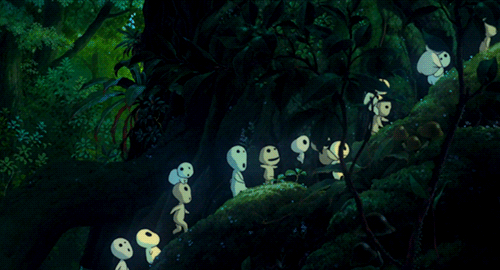
Something I have seen a lot of people within the Solarpunk sphere talk about and wonder is: "When did we stop seeing ourself as something outside of nature?" And given that I actually had a module on that (Social Geography, best module I ever had, given we had an anarchist professor!) I thought I could quickly explain this one.
So, the names come, in the end, from Latin and back when those words were considered in Latin, the difference was, that nature was a thing that was innate, while culture had volition behind it. You could change nature into culture by putting work into it.
Something that might surprise you is, that the idea of nature then was never quite big for most of European history. And let me make one thing clear: While we have these ideas also played with in Buddhist culture - especially in East Asia - the way we define it right now is a Western idea.
And that idea... Well, that idea came with colonialism. The thing many do not realize is, how much of the rules and "lines in the sand" that we use in our culture came from colonialisation, came from the desire to make "our" culture different from "theirs". It is shown in the way we eat, in the way we raise children, in the way we view gender and sexuality. And, yes, in the artificial border between nature and culture.
Before I tell you more about this, let me please say here: Yes, this is contradictive. I am aware of it. I am not the one who came up with the contradiction. White settlers did that all on their own.
When the settlers came to America they found a landscape very, very different from what they were used to from Europe. After all, Europe has been changed through human hand for at that point about 1600 years. (And for you Europeans out there: Researching how much forest your local area might have lost through the Romans is always a "fun" thing to do! Because the Romans destroyed a lot of European ancient forests.) In Europe, even at the wildest places, there was usually some evidence of human habitation - but this was not true for the Americas. Not because there were no people there, but rather because the people interacted with the environment very differently.
See, the European idea - while never quite that defined until this point - was really, really based on this thought that nature can be turned into culture. And that this transformation was in fact a good thing to happen. So, when the settlers arrived in the Americas they did not see "culture" there, only "nature" and set out to turn that "nature" into "culture".
Of course, we - modern people living today - do realize that indigenous people had in fact cultures of all sorts and that the actual difference was, that they just did not see that culture as something different from nature, rather than a part of it. Because their culture had not been influenced by Romans. But the settlers back then did not see this or rather did not want to see this. So they "cultured" the land, with the ideas about nature and culture being further formalized at that point.
It kinda stayed like this until the late 19th century, when Madison Grant, the originator of eco fascism came to be influencial. And now he saw something that the settlers until this point were unable to see: The indigenous people do stuff with the nature around them! They change it! For example through controlled burning of forests and things like that.
And this made Madison Grant very angry, because he was very much off the opinion that nature should be "unsoiled" by human hands. So... he made sure that those indigenous people got once more pushed out of the areas they were living, with the same areas being declared natural parks and no longer interfered with by humans (except, of course, all the tourists who destroyed it bit by bit). Leading... To a lot more wild fires.
So, where does this leave us in terms of the culture/nature divide?
Well, the idea has been there since ancient Rome and has very much influenced how much we view nature as its own thing. But within Rome nature was still not quite seen as the opposite of culture - as one could turn into the other. Under the Roman view an abandoned house or a field that was no longer cared for would turn back into nature, while anything could become culture just by interacting with humans.
The modern view really came through colonialism and the way colonialist did not understand (and did not want to understand) indigenous practices. This made people more and more drift towards the understanding of humans being an entirely different thing from nature.
But this is wrong, of course. We are part of nature. We are just animals with fingers and slightly larger brains. And many indigenous cultures understood this. In the end it was the greed of some that made us loose this connection to nature. And that is exactly why we are in this climate change related mess right now.

#solarpunk#history#culture#nature#culture-nature divide#colonialism#anti colonialism#indigenous knowledge#indigenous people#national parks
168 notes
·
View notes
Text
Dozens of new wildfires were discovered across Alberta amid high temperatures, dangerously dry conditions and high winds on Thursday.
More than 10,000 people across Alberta are now affected in some way or another by mandatory evacuation orders.
There were many Alberta Emergency Alerts issued and updated throughout the day as the fires grew and threatened more properties.
A 6 p.m. emailed update from Alberta Wildfire said there were 72 active wildfires across the province but in the hours after that bulletin was issued, even more infernos showed up on the government agency’s live wildfire dashboard. [...]
Continue Reading.
Tagging: @politicsofcanada, @abpoli
288 notes
·
View notes
Text
https://ictnews.org/news/colorado-mountain-renamed-mount-blue-sky

Colorado mountain renamed Mount Blue Sky
The mountain was previously named after former territorial governor, John Evans, who authorized the Sand Creek Massacre
#indigenous#native american#ndn#good news#colorado#mt blue sky#colonialism#renaming#nature#environment
113 notes
·
View notes
Text

Disaster capitalism has taken many forms in different contexts. In New Orleans after Hurricane Katrina in 2005, there was an immediate move to replace public schools with charter schools, and to bulldoze public housing projects to make way for gentrifying townhouses. In Puerto Rico after Hurricane Maria in 2017, the public schools were once again under siege, and there was a push to privatize the electricity grid before the storm had made landfall. In Thailand and Sri Lanka after the 2004 tsunami, valuable beachfront land, previously stewarded by small-scale fishers and farmers, was seized by real estate developers while their rightful occupants were stuck in evacuation camps.
It’s always a little different, which is why some Native Hawaiians have taken to calling their unique version by a slightly different term: plantation disaster capitalism. It’s a name that speaks to contemporary forms of neocolonialism and climate profiteering, like the real estate agents who have been cold-calling Lahaina residents who have lost everything to the fire and prodding them to sell their ancestral lands rather than wait for compensation. But it also places these moves inside the long and ongoing history of settler colonial resource theft and trickery, making clear that while disaster capitalism might have some modern disguises, it’s a very old tactic. A tactic that Native Hawaiians have a great deal of experience resisting.
#maui wildfires#hawaiʻi#water use#capitalism#real estate development#profiteering#disaster capitalism#colonialism#natural resources
122 notes
·
View notes
Text
It’s #WorldMeerkatDay!

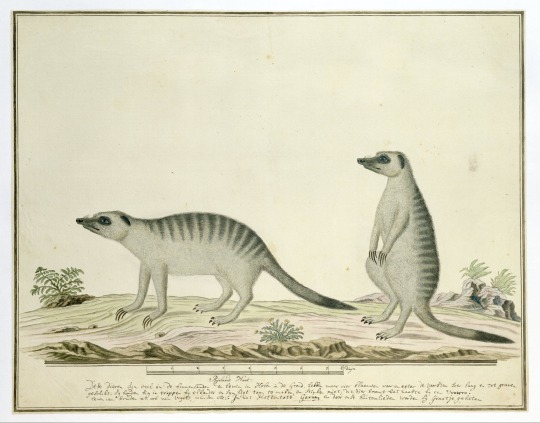
Robert Jacob Gordon (Dutch, 1743-1795)
Meerkats, 1773-80 + 1777-86
watercolor drawings from the Gordon African Collection (illustrations made during his expeditions to South Africa). Rijksmuseum collection.
#animals in art#European art#18th century art#works on paper#watercolor#illustration#historical sciart#sciart#scientific illusration#natural history illustration#Robert Jacob Gordon#Gordon African Collection#African animals#Dutch art#colonial art#Rijksmuseum#animal holiday#meerkat#meerkats#World Meerkat Day
144 notes
·
View notes
Text


I originally queued that "practice surgery" bill with the intent for Vasso to gain some medical experience, but I really like the idea of Bella becoming Doctor Darlington-Whit, so perhaps she will see more surgery in the near future.

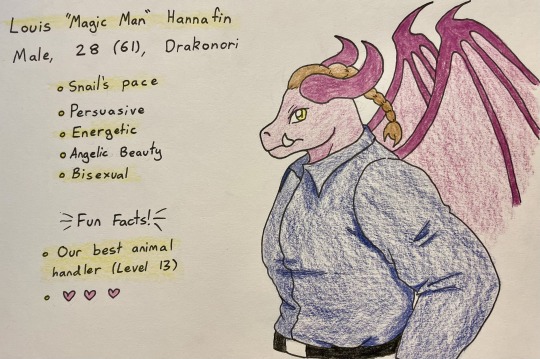
Yay Magic Man!!!!!! I love him so much I am going to get so sick of drawing his wings he is so cool and badass
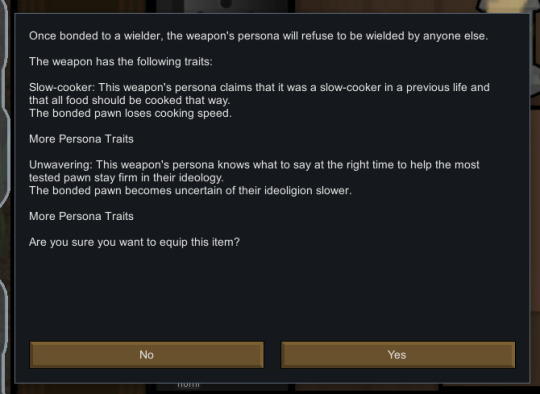
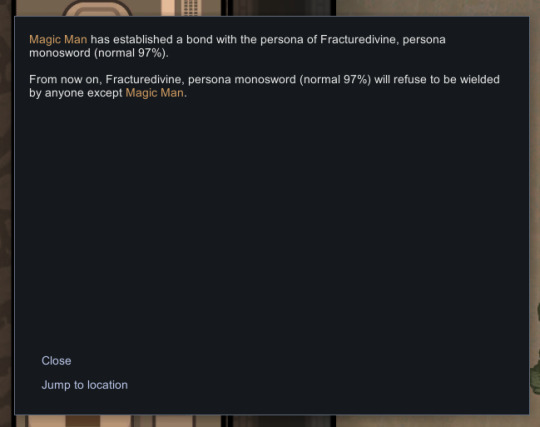
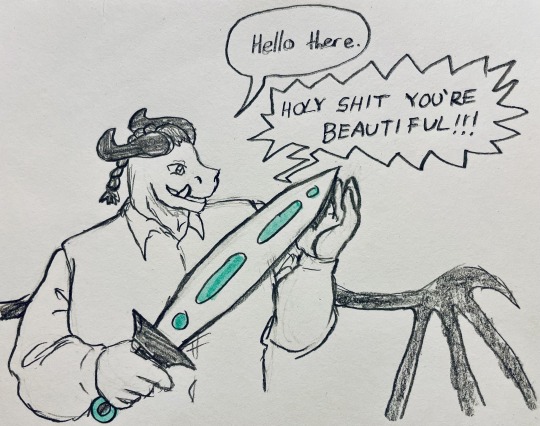
Magic Man, as my colonist with the highest melee ability (level 9), gets the honour of having a magic sword judge his every action until the end of time <3


M.M. is the best colonist, sorry everyone. I don't make the rules.
Unfortunately, we only managed to snag one of the bionic thrumbos (his name is Poison). His lady friend wandered off the map before M.M. could reach her.
First | Next | Previous
#rimworld#gracie plays#The Children of Ecthuctu#art#my art#traditional art#rimworld art#unpolished art#slightly more polished art than usual#Bella is going to be such a good doctor#Gotta start their education young y'know#She's going to know her way around surgery like it's second nature#I'm so proud of her <3#I love Magic Man but he's a pain in the ass to draw#Cool wings#Frustrating head shape#impid horns are easier#but he's still awesome#I bet Fracturedivine adores him#welcome to the colony Poison#best thrumbo#I love him to pieces#have a fabulous day everyone!!
48 notes
·
View notes